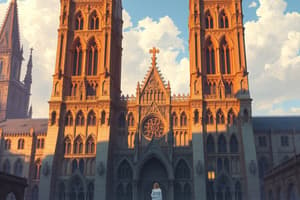Podcast
Questions and Answers
What architectural feature is primarily associated with Romanesque churches like the Church of Sainte-Foy?
What architectural feature is primarily associated with Romanesque churches like the Church of Sainte-Foy?
- Pointed arches
- Flying buttresses
- Barrel-vaulted nave (correct)
- Dome structure
What was the primary purpose of the radiating chapels in the Church of Sainte-Foy?
What was the primary purpose of the radiating chapels in the Church of Sainte-Foy?
- To allow pilgrims to visit saint’s shrines (correct)
- To serve as storage spaces for religious artifacts
- To hold musical instruments for church services
- To accommodate church officials during services
Which feature is depicted on the tympanum of the Church of Sainte-Foy?
Which feature is depicted on the tympanum of the Church of Sainte-Foy?
- Scenes from the life of Saint Foy
- The Last Judgment (correct)
- The ascension of Mary
- The crucifixion of Jesus
What material was primarily used to create the reliquary of Saint Foy?
What material was primarily used to create the reliquary of Saint Foy?
What was a major reason pilgrims visited holy sites like the Church of Sainte-Foy?
What was a major reason pilgrims visited holy sites like the Church of Sainte-Foy?
Flashcards
Cruciform Plan
Cruciform Plan
A key architectural feature of Romanesque churches, resembling a cross in its layout. It served both symbolic and practical purposes, guiding pilgrims and managing crowds.
Tympanum
Tympanum
A semicircular relief sculpture located above the central entrance of a church, often depicting a significant scene.
Barrel-Vaulted Nave
Barrel-Vaulted Nave
The central area of a church, usually vaulted with a barrel-shaped ceiling, creating a grand, imposing space.
Radiating Chapels
Radiating Chapels
Signup and view all the flashcards
Reliquary
Reliquary
Signup and view all the flashcards
Study Notes
Church of Sainte-Foy, Conques, France
- Romanesque church, constructed c. 1050–1130 CE.
- Reliquary of Saint Foy, 9th century CE, with later additions.
- Materials: stone (architecture); stone and paint (tympanum); gold, silver, gemstones, and enamel over wood (reliquary).
Pilgrimage Significance
- Pilgrimage meant closeness to God.
- Pilgrims traveled to holy sites, and the church was a focal point for this.
Romanesque Church Design
- Barrel-vaulted nave, lined with arches on the interior.
- Cruciform plan (cross shape) aided crowd control.
- Radiating chapels housed saint's shrines; Saint Foy's was important.
Tympanum and Reliquary
- Last Judgment depicted on the tympanum (central portal's relief carving).
- Reliquary of Saint Foy highly valued by pilgrims.
- Donations added gemstones to the reliquary over time.
Studying That Suits You
Use AI to generate personalized quizzes and flashcards to suit your learning preferences.




